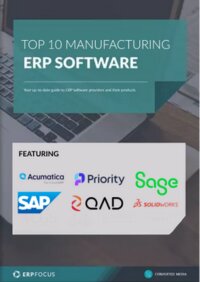ERP in Manufacturing Series: Purchasing
If your organization has a strong and focused culture around purchasing control and efficiency, and a long history of knowing how to make money on intelligent buying, then ERP will likely only yield your purchasing department incremental improvements in efficiency and information management. On the other hand, if your purchasing department has always been a sort of stand-alone, “necessary evil” part of your organization, then you have the potential to make more money with an efficient ERP purchasing module than with all of the other modules combined.
If the above statement sounds like hyperbole, just consider the logic of improvement. What percent of your total product cost comes from purchased items – raw material, component parts, or direct materials? Normally, it is at least fifty percent, often as much as seventy-five percent. It isn’t that ERP purchasing modules are that much more effective; it’s because purchasing is where the cost opportunity is.
Making Data Work to your Advantage
What kind of issues surface to make purchasing more effective as a result of implementing ERP in a manufacturing environment? The first is increased data accuracy, particularly around terms and prices. It is often easy to make a pricing or terms error when filling out a purchase order. The vendor will point out any errors which would work in your favor (e.g., price is lower than it should be), but it will take a pretty unique vendor who flags you if an error works in his favor. ERP systems provide rigid logic for enforcing the buying agreements purchasing reaches; purchasing just needs to make certain the rules are loaded accurately and maintained.
Key Learning: 10 steps to manufacturing ERP success
Another is increased control over negotiating through vendor consolidation. If legacy processes had evolved such that the organization had sixteen approved vendors to supply identical A.C. motors, then consolidating that number down, and negotiating a better price for a higher volume would be a natural course of action for a purchasing area.
A third area which could yield savings, through process discipline is the approval limit rules that can be put into place. Interesting discussions about spending limits occur when people try to articulate why the maximum limit for spending on computer hardware without supervisory approval should be $250, but for ordering steel stock for manufacturing operations, the maximum should be $250,000. Defining when, how much, and to whom a purchase requisition should be escalated for approval always results in a more clearly articulated purchasing policy.
An opportunity for time savings, if not necessarily large dollar savings, occurs when you develop enough confidence in your planning system output to allow it to automatically generate purchase requisitions. Be cautious and obsessive about understanding this feature, however; it is likely when you throw the switch the ERP system will attempt to massively over-buy or under-buy, depending on the rules you’ve loaded in master data.
Free white paper

Manufacturing ERP Vendors: Ten Critical Questions To Ask Them

Featured white papers
Related articles
-

4 training tips for manufacturing ERP success
These four training tips will help your employees get the most out of your new manufacturing ERP ...
-

CMMC Compliance: What Aerospace and Defense Manufacturers Need to Know
Key insights on CMMC compliance, deadlines, and securing DoD contracts with CMMC 2.0 certificatio...
-

ERP for make-to-order manufacturing
How can ERP help your make-to-order manufacturing business thrive?




